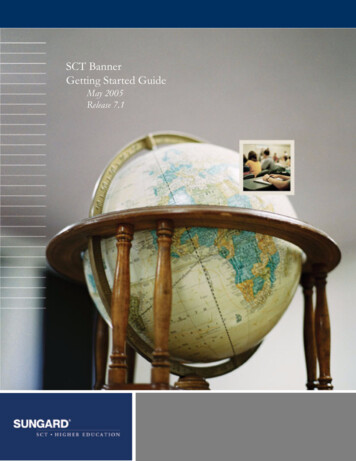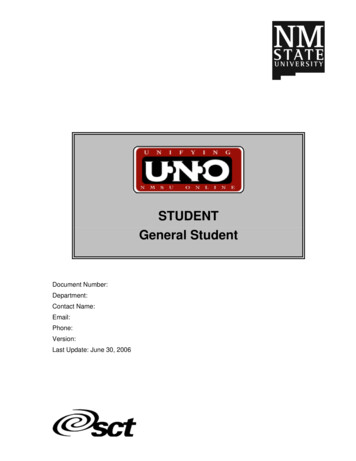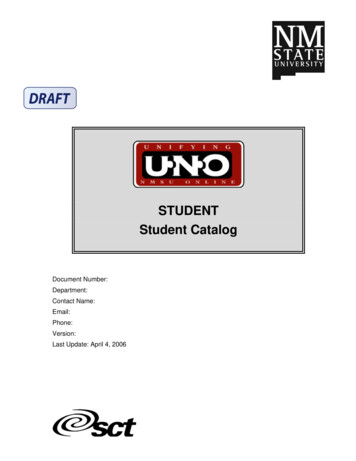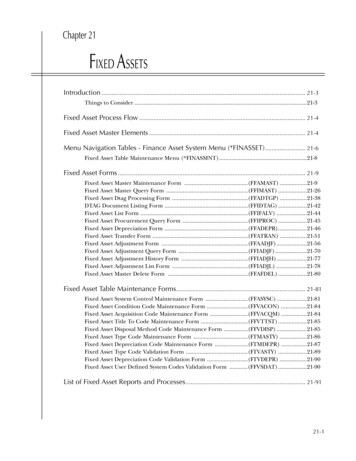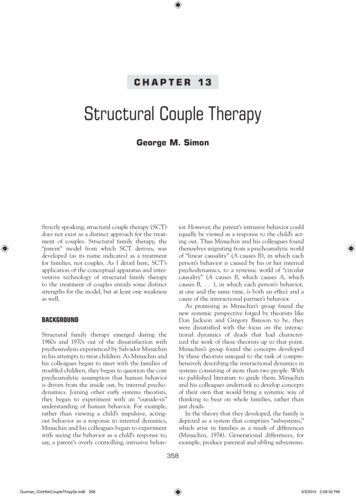
Transcription
C h a p t er 13structural Couple TherapyGeorge M. SimonStrictly speaking, structural couple therapy (SCT)does not exist as a distinct approach for the treatment of couples. Structural family therapy, the“parent” model from which SCT derives, wasdeveloped (as its name indicates) as a treatmentfor families, not couples. As I detail here, SCT’sapplication of the conceptual apparatus and interventive technology of structural family therapyto the treatment of couples entails some distinctstrengths for the model, but at least one weaknessas well.BACkgroundStructural family therapy emerged during the1960s and 1970s out of the dissatisfaction withpsychoanalysis experienced by Salvador Minuchinin his attempts to treat children. As Minuchin andhis colleagues began to meet with the families oftroubled children, they began to question the corepsychoanalytic assumption that human behavioris driven from the inside out, by internal psychodynamics. Joining other early systems theorists,they began to experiment with an “outside-in”understanding of human behavior. For example,rather than viewing a child’s impulsive, actingout behavior as a response to internal dynamics,Minuchin and his colleagues began to experimentwith seeing the behavior as a child’s response to,say, a parent’s overly controlling, intrusive behav-ior. However, the parent’s intrusive behavior couldequally be viewed as a response to the child’s acting out. Thus Minuchin and his colleagues foundthemselves migrating from a psychoanalytic worldof “linear causality” (A causes B), in which eachperson’s behavior is caused by his or her internalpsychodynamics, to a systemic world of “circularcausality” (A causes B, which causes A, whichcauses B, . . .), in which each person’s behavior,at one and the same time, is both an effect and acause of the interactional partner’s behavior.As promising as Minuchin’s group found thenew systemic perspective forged by theorists likeDon Jackson and Gregory Bateson to be, theywere dissatisfied with the focus on the interactional dynamics of dyads that had characterized the work of these theorists up to that point.Minuchin’s group found the concepts developedby these theorists unequal to the task of comprehensively describing the interactional dynamics insystems consisting of more than two people. Withno published literature to guide them, Minuchinand his colleagues undertook to develop conceptsof their own that would bring a systemic way ofthinking to bear on whole families, rather thanjust dyads.In the theory that they developed, the family isdepicted as a system that comprises “subsystems,”which arise in families as a result of differences(Minuchin, 1974). Generational differences, forexample, produce parental and sibling subsystems.358Gurman ClinHbkCoupleThrpy5e.indb 3583/3/2015 2:09:32 PM
13. Structural Couple TherapyPrecisely because they are produced by differences,subsystems were conceived by Minuchin’s group asbeing surrounded by “boundaries,” which demarcate subsystems one from another.The internal differences that give rise to subsystems are potentially a good thing for the family. That this is so becomes clear when we realizethat the family is itself only a subsystem— of anextended family, possibly, but certainly a subsystem of the broader society in which it is immersed.A family is functional to the degree that it nurtures in its members the ability to negotiate wellthe demands of the world outside the family(Minuchin & Fishman, 1981). Performing thistask of socialization requires that the family beable to adapt itself to changes in its social environment. However, it also requires that the family,when necessary, be able to exercise some agencyin changing its environment, with an eye towardrendering the environment more supportive of thefamily’s functioning.The family system is better equipped to engagein this kind of complex interaction with the outside world if it has access to as many internalresources as possible. This is why the presence ofinternal differences that give rise to subsystemsis potentially good news for the family. A familywith a significant array of complexly cross- linkedsubsystems should find itself richly endowed withresources to manage its dealings with the outsideworld. Such will be the case, however, if, and onlyif, the various subsystems interact with each otherin a way that allows the family as a whole to benefitfrom the resources contained in each subsystem.To describe and to assess how adaptively family subsystems interact with each other, Minuchin(1974) proposed that we think of the boundariesthat demarcate subsystems one from another asvarying in permeability, from diffuse to rigid. A“diffuse” boundary between two family subsystemsis one that does not adequately differentiate thefunctioning of the two subsystems, resulting in adeprivation of resources to the family as a whole.The presence of a diffuse boundary can be assessedwhen two family subsystems have no clear divisionof labor and/or focus between them. Subsystemsseparated by a diffuse boundary are said to be“enmeshed.”Equally debilitating to the family is the presence of “rigid” boundaries between subsystems.Here, differentiation has been carried to the pointthat resources in one subsystem are unavailable tothe other. Subsystems separated by a rigid boundary are said to be “disengaged.”Gurman ClinHbkCoupleThrpy5e.indb 359359The constellation of subsystems in a family,along with the boundaries, whether diffuse, adaptive, or rigid, that separate the various subsystemsfrom each other, are collectively referred to as the“structure” of the family. It must be kept in mindthat in devising the heuristic metaphors of familystructure, subsystems, and boundaries, Minuchinand his colleagues remained anchored in theassumptive world of systems thinking. Thus circular causality was seen as governing transactionsboth within and between subsystems.Functional–Dysfunctional CouplesMost readers no doubt realize that this brief overview of structural family therapy’s foundationalconcepts does not include the couple as an explicitunit of analysis. This omission was not an oversight. To reiterate the point made at the beginningof this chapter, structural therapy is, first of all, atherapy of families, and only derivatively a therapyof couples.When structural theorists consider couple functioning, they do so after having first articulated aview of family functioning. Inevitably, then, structural theorists’ view of couples, both functionaland dysfunctional, is set against the background ofthe theory’s view of families. The couple is viewedas a family subsystem, no more and no less, andassessment of how well or poorly a couple is functioning is based on the theory’s notion of whatconstitutes adaptive functioning for any and allfamily subsystems.This conceptual arrival in the world of couplehood, after a journey through the world of familylife, entails a distinct theoretical strength and onepractical weakness for SCT. I describe the deficit— and, I hope, begin to remediate it—later in thechapter. Here, I briefly describe the strength.Because SCT views the couple as a subsystem(perhaps of a family including children, perhaps ofan extended kinship network, certainly of numerous societal- level systems), the approach does notbase its understanding of the couple on a notionof romantic love. Structural theorizing aboutthe couple recognizes that the ways people formcouples and their expectations in doing so havevaried dramatically from time to time and fromplace to place over the course of human history(Minuchin, Lee, & Simon, 2006). The notion thatoptimal couple relating is based on mutually experienced and reciprocally expressed romantic love isof rather recent vintage. Although this notion has3/3/2015 2:09:32 PM
360I. MODELS OF COUPLE THERAPYalmost unquestioned currency among the middleclasses of the developed nations of the West, basing an approach to couple therapy on this notionruns the risk of unnecessarily limiting the applicability of the approach.Precisely because it evaluates couple functioning generically, utilizing the same conceptual repertoire that it employs to evaluate the functioningof any family subsystem, SCT is applicable to couples that have come together and remain together,or perhaps are coming apart, for a whole host ofreasons. It can certainly be applied to coupleswhose members understand their relationship inwhat is considered the “traditional” way amongthe middle classes of the West (i.e., as being basedon romantic love and as finding formal expressionin the institution of marriage). However, it canalso be applied to couples whose members, whilespeaking the language of romantic love, do notintend ever to marry. Equally, it can be applied tocouples whose members, while choosing to marry,do not expect romantic love to play a significantrole in the way that they relate to each other. Itcan be applied to couples whose members seektherapy to facilitate their uncoupling, as well as tocouples whose members desire to remain together.What, then, in the view of SCT, characterizes afunctional couple? Like any functional subsystem,a functional couple is surrounded by a boundary sufficiently defined to demarcate the couplefrom its environment, yet sufficiently permeableto allow for adaptive exchange with the environment. Functional couples also share with all otherfunctional subsystems the kind of internal differentiation associated with the presence of a significant array of resources. Thus functional couplesnot only tolerate but also actively encourage differences between the partners. They are markedby an ethos and a style of interaction that inviteseach partner to see the other partner’s differencesas a resource rather than as a threat.The dysfunctional couple, in distinction, is onewhose external boundary is excessively diffuseor rigid. A diffuse boundary deprives the couplesubsystem of integrity, resulting in partners’ lackof identity as a couple. A rigid boundary, on theother hand, cuts the couple off from its environment. The couple behaves not as a subsystem, butas a world unto itself. This results inevitably infunctional and emotional overload, and perhapsin debilitating lack of fit between the couple andits social environment as well.The dysfunctional couple also displays extremesin its approach to internal differentiation. Differ-Gurman ClinHbkCoupleThrpy5e.indb 360ences between the partners either are not tolerated or are rigidified into warring positions (orat least into positions in which partners do notengage in significant dialogue with each other). Inboth scenarios, the couple subsystem is deprivedof resources.Cultural ConsiderationsIt is likely that in reading the description just givenof SCT’s notion of functional and dysfunctionalcouples, many of you noted how abstract andvague the description is. The dysfunctional coupleis defined as having “excessively” rigid or diffuseboundaries. “Excessive,” you might well ask, inwhose estimation? The therapist’s? If so, how doesthe therapist avoid imposing his or her own aesthetic preferences regarding how human beingsshould relate when judging that a given couple’sboundaries are “too rigid” or “too diffuse”? Sincesuch preferences are, to a degree that frequentlyescapes our awareness, conditioned by culture,class, and gender role socialization, this last question might aptly be recast as follows: How does thetherapist avoid engaging in some form of culturalcolonialism when he or she assesses the structureof a client couple (cf. Paré, 1996)?In collaboration with my colleague DanielSciarra, I have proposed a means by which theheuristically useful structural notions of “boundaries,” “enmeshment,” and “disengagement” maybe retained, while avoiding the pitfall of culturalcolonialism (Sciarra & Simon, 2008). We proposethat couples themselves must make the determination that their subsystem boundaries are dysfunctional. We consider that a couple communicatessuch a determination when it defines into existence a problem that it judges merits therapeuticattention. Following the collaborative languagesystems model of therapy pioneered by Andersonand Goolishian (1988), we assume that problemsdo not have any kind of objective existence: “Likeeverything else in the human world, a problemexists only when it is consensually defined intoexistence by members of a system” (Sciarra &Simon, 2008, p. 64). To use Anderson and Goolishian’s felicitous phrasing, a couple’s defining intoexistence of a therapy- meriting “problem” constitutes an “alarmed objection” by the couple— theirway of signaling that they have determined thatthere is something amiss within the system.Of course, the SCT therapist has a predetermined notion of where to look for what is “amiss”in the couple that presents itself to him or her for3/3/2015 2:09:32 PM
13. Structural Couple Therapytreatment: The problem lies in a structure characterized by boundaries, within and around the couple subsystem, that are maladaptively diffuse and/or rigid. There is no camouflaging the fact thatthis notion of where to look for malfunction in thecouple is brought to the therapy by the therapist,not the clients. What the clients do bring, however, is their own assessment that there is, in fact,something malfunctioning in their life together,expressed in their self- generated defining intoexistence of a “problem” that they judge merits thecommencement of couple therapy.In order for these ideas to provide the buffer against therapeutic colonialism that they areintended to provide, the very first thing that theSCT therapist must determine when meetinga new client couple is whether their presentingproblem is genuinely self- defined by the couple,or has been defined for them by some externalagent, who also has the power to coerce them intotherapy (e.g., a family court judge or a child protective services worker). Thus, before engaging inthe project of assessment, it is incumbent on thetherapist to join with a client couple sufficientlyto allow its real customership for therapy to berevealed (Sciarra & Simon, 2008).If it becomes clear to the SCT therapist that thecouple’s presenting problem has been defined forthe partners, rather than having been self- defined,he or she should not proceed into therapy- as-usualmode. In particular, the therapist should assiduously avoid assessing the couple, using the model’sstructural notions. Instead, the therapist can offerhis or her services to help the couple membersremove themselves from the supervision of theoutside agent who has pushed them into therapy(Sciarra & Simon, 2008). Therapy “proper,” andwith it, the use of SCT’s notions of functional anddysfunctional couple structure, commences if andonly if the couple members at some point volunteer to the therapist that they do, in fact, have aself- defined problem that has been a concern tothem and that they would like to make the focusof treatment.Development of Dysfunctional StructureSo what is SCT’s explanation for the fact thatwhereas some couples crystallize an adaptivestructure, others drift into an organization characterized by the dysfunctional features just listed?Structural theory has something to say about whencouples are susceptible to developing a dysfunctional structure. Periods in a couple’s life whenGurman ClinHbkCoupleThrpy5e.indb 361361partners experience a press for change, originating either from a normative life cycle transition(e.g., the arrival of a first child, the leaving homeof a young adult child) or from some acute stressor(e.g., the occurrence of a natural disaster, extendedunemployment of one of the partners), are seen instructural theory as periods when the couple is atrisk of developing a dysfunctional structure. However, as regards why some couples respond to suchperiods adaptively, while others do not, structuraltheory is relatively mute.In large measure, SCT’s silence on this matter reflects the model’s nondeterministic outlookon the development of human systems. Preciselybecause human systems are human, they are complex, multifaceted entities, whose developmentover time cannot be subjected to the kind ofrigorous modeling that is required to make accurate predictions. The structure exhibited by anygiven couple subsystem at any given point in itsdevelopment is the product of the complex andlargely idiosyncratic interplay of numerous factors,including the family- of- origin histories of the individual partners, the partners’ respective biologicalendowments, the sociocultural environment inwhich the couple is immersed, chance events thathave influenced the couple’s life, and (not least)the couple’s decisions about how to deal with allof these factors.A corollary of SCT’s nondeterministic outlookon couple development is the belief that a givencouple’s structure at any point in its developmentcould always have turned out to be something different from what it is. A different decision made bythe couple, a different response to some exigencyof the couple’s life, would have resulted in thecrystallization of a different structure. This beliefentails a crucial implication for the way SCT isconducted. Structural therapy is thoroughlyinformed by what I have termed an “assumption ofcompetence” (Simon, 1995). No matter how dysfunctional the structure that a couple exhibits atthe outset of treatment, it is never assumed thatthis structure reveals some essential, core qualityof the couple. Because SCT assumes that the couplecould have evolved a structure different from the dysfunctional one now being displayed, it also assumesthat the couple possesses in its relational repertoireadaptive resources that currently lie dormant. SCTis not, therefore, an attempt to put somethingnew into a couple viewed as deficient; rather, it isan attempt to activate what is already there, butlatent, in a couple viewed as fundamentally competent. I soon demonstrate what a thorough- going3/3/2015 2:09:33 PM
362I. MODELS OF COUPLE THERAPYinfluence this assumption of competence has onthe way SCT is practiced.The Practice of SCTAs is the case with every model of psychotherapy,the process of therapy prescribed by SCT followsrigorously from the way the model conceptualizeshuman functioning. The mechanism of therapeutic change in SCT, the structure of the therapy process, the way assessment is conducted and the goalsset, the role of the therapist, and the therapeutictechniques employed all flow from the model’s systemic conceptualization of couple functioning.Mechanisms of ChangeAs noted earlier, structural therapy fully endorsesthe concept of circular causality. In the view ofSCT, the most therapeutically relevant cause of acouple member’s behavior is not that person’s history,biology, thinking, or feeling. Rather, the most proximal cause is that person’s here-and-now experience ofthe partner’s behavior. And, of course, the partner’sbehavior is itself primarily caused by his or herhere-and-now experience of the other’s behavior.In the conceptual universe of SCT, here-andnow relational experience elicits and maintainscouple members’ patterned behavior. Thus it follows that a therapist who wants to change behavior must change how couple members experienceeach other. The mechanism of change in SCT is theproduction of new relational experiences for clients.It is the experience of receiving different behavior from the partner that induces a couple member to behave differently toward the partner, andvice versa. In SCT, clients change each other bybehaving differently toward each other. The jobof the therapist is to facilitate this internal changeprocess within the couple subsystem.It is precisely because SCT is focused entirelyon the production of novel, in- session relationalexperiences for its clients that enactment constitutes the centerpiece of the therapeutic processprescribed by the model (Aponte, 1992; Simon,1995). “Enactment” refers to those moments intherapy when couple members interact directlywith each other. It is in this direct interactionwith each other during sessions that clients havethe new relational experiences constituting themechanism of change in SCT.I have much more to say about enactment later,at various points in this chapter. Here, I want toGurman ClinHbkCoupleThrpy5e.indb 362make clear that enactment is more than simply onetechnique among many utilized in the practice ofstructural therapy. Directly linked as it is to structural therapy’s understanding of the mechanism oftherapeutic change, enactment is better conceivedas a leavening agent that is mixed into everyaspect of the therapy process, from assessment totermination. Minuchin, Nichols, and Lee (2007)express this idea by asserting that enactment ismore an attitude of the structural therapist than atechnique that he or she utilizes. Everywhere, andat all times, the SCT therapist is oriented towardhaving couple members enact their relational lifein the here-and-now of the therapy session, ratherthan talk about the relational life they live outsidethe session. Thus enactment organizes the therapysession as a setting in which couple members haveexperiences. Via enactment, couple members experience the futility and dysfunctionality of theircurrent way of relating, and the possibility of relating in new, more functional ways.Structure of the Therapy ProcessSCT’s understanding of the mechanism of therapeutic change dictates the manner in which thetherapist manages the nuts-and-bolts details ofhow the therapy process is structured. Matterssuch as who should attend therapy sessions, howoften sessions should occur, and whether referralsfor medication evaluation should be made are alldecided in light of SCT’s understanding of thenature of couple dysfunction and how such dysfunction is remediated via the therapy process.As I have just described, SCT aims entirely atchanging how couple members experience eachother. Obviously, one couple member cannotexperience the other differently if that person isnot in the therapy room with him or her. Thus, ingeneral, both couple members are expected to bepresent together in every session of SCT.Even when the SCT therapist succeeds in getting couple members to experience each otherdifferently during sessions, he or she fully expectsthat during the early phase of therapy, those novelrelational experiences are going to “wash out”during the period between sessions, as the couplesubsystem’s structure reasserts itself and the couplemembers return to their usual way of relating toeach other. (I have more to say about this “relational inertia” later in the chapter, when I discussgoal setting and technical aspects of the therapeutic process.) Since the therapist wants the novelrelational experiences produced in session to build3/3/2015 2:09:33 PM
13. Structural Couple Therapyin intensity to the point where definitive restructuring of the couple subsystem occurs, wheneverpossible he or she structures the therapeutic process so that sessions occur, at least during the earlyphase of treatment, on a weekly basis.While conjoint sessions are the rule in SCT,there is one important exception to this rule. Itoccurs when the therapist suspects that one couplemember is behaving violently or abusively towardthe other, and that this fact is not being reportedopenly in sessions. Under such circumstances, thetherapist arranges individual sessions with eachpartner, thereby providing the abused partner asafe forum to talk about the violence and/or abusethat is occurring. Because violence or abuse thatcannot be talked about openly in a conjoint session is likely to be the kind that is not amenableto change via conjoint treatment, if individualsessions reveal that abuse or violence is occurring,then couple therapy is not continued beyond thatpoint. Rather, the abused partner is referred toservices that help to ensure his or her safety. Thetherapist also provides an appropriate referral tothe abusing partner, provided that, in the therapist’s judgment, doing so will not place the abusedpartner at heightened risk of receiving some kindof retaliatory response from the abuser.Whereas the SCT therapist readily makes referrals in the situation just described, he or she is slowto see the need to refer a client for a medicationevaluation. It is not that that the structural therapist does not recognize the influence of geneticsand biology on human behavior. The contribution of genetic endowment to human behavior hasby now been too well documented to be ignored.However, structural theory has always assumedthat family structure plays a crucial mediating rolebetween genes and their behavioral expression.Adaptive family structure, the model assumes,works to suppress whatever genetic tendency family members might possess to become psychiatrically symptomatic; likewise, maladaptive familystructure works to activate such genetic vulnerabilities. This assumption of structural theoryhas been validated a number of times by researchdesigned to tease out the interaction betweengenetic endowment and family dynamics (e.g., seeWynne et al., 2006).Recognizing the power of relational dynamicsboth to activate and to suppress psychiatric symptoms, the SCT therapist responds to the presenceof such symptoms in one or both members of aclient couple by doing what he or she would dowith any couple: begin to work to restructure theGurman ClinHbkCoupleThrpy5e.indb 363363couple subsystem. The therapist does so, confident that an adaptive restructuring of the couplerelationship will result in a significant abatementor even the remission of whatever psychiatricsymptomatology was present at the outset of thetherapy.The SCT therapist only sees a need to make areferral for adjunctive treatment in circumstancesin which a client’s symptoms entail an imminentand substantial threat to harm self or others.Under such circumstances, the therapist cannotwait until an adaptive restructuring of the couplesubsystem has ameliorated the client’s symptoms.Such circumstances require the more or less “quickfix” that medication might provide. Thus, underthese circumstances, the therapist refers the symptomatic client for a medication evaluation.Whereas relational dynamics play a crucial rolein the activation– suppression of biology- involvingpsychiatric symptoms, they are not the only contributing factor. Thus, even at the end of a successful course of SCT, some residual expression ofsuch symptoms might remain in one or both couple members. If, at this point, the clients expressthe desire to see whether psychopharmacologicaltreatment might produce a further reduction insymptoms, the SCT therapist gladly provides areferral for a medication evaluation.AssessmentWhat the SCT therapist primarily assesses during the initial encounter with a client couple is,of course, the structure of the couple subsystem.However, it is important to recall that the SCTtherapist will enter upon the process of assessmentonly with a couple that has presented itself fortreatment with a problem that its own membershave defined into existence.Structural assessment of the couple subsystementails an assessment of the permeability of theboundary surrounding the subsystem and the waydifferentiation is handled within the subsystem.The SCT therapist expects that most couplespresenting for treatment are surrounded by anexternal boundary that is either excessively diffuse or excessively rigid. The model also predictsthat most client couples either avoid differentiation between the partners—“We think alike onalmost everything”—or exaggerate differentiationto the point that the only conceivable alternativesfor the couple members are to live in a state of perpetual conflict or to avoid significant interactionwith each other altogether.3/3/2015 2:09:33 PM
364I. MODELS OF COUPLE THERAPYThe client couple carries its structure with itinto the therapy room. The unarticulated rulesand expectations that organize the couple’s relational life outside the therapy room also organizehow the partners behave in the therapy room.Thus all the SCT therapist need do to bring thecouple subsystem structure to the fore is to invitethe partners to begin interacting with each otherin the therapy session. Such direct interactionbetween couple members is, of course, what SCTrefers to as “enactment.” Just as enactment, laterin the therapy process, will be the SCT therapist’sprimary medium for changing the couple subsystem structure, so too is it the therapist’s primarytool early in the therapy process for assessing thatstructure.Any enactment the therapist elicits during thefirst session will probably provide a glimpse intothe couple subsystem structure. However, becausethe SCT therapist is particularly interested inhow the couple subsystem handles internal differentiation, and how this differentiation is circularly linked to the permeability of the subsystem’sexternal boundary, certain kinds of enactment arelikely to have more assessment value than others.Specifically, enactments in which couple members air and explore differences between them arelikely to provide the therapist with the clearestview of the couple subsystem structure. Therefore,relatively early in the first therapy session, theSCT therapist looks for an opportunity to elicit anenactment between the partners on some matteron which they appear to differ.Some couples cite intractable differences as precisely the problem that led them to seek therapy.Eliciting an enactment focused on differences isusually easy in such cases. After allowing eachpartner to articulate his or her position on thecontroversial issues(s) in question, the therapistmerely directs the clients to continue their discussion with each other.The situation is different when a client coupleidentifies symptoms in one partner as the presenting problem for therapy. In such circumstances,the partners frequently are in substantial agreement about the nature of the symptoms, andeven about poss
ventive technology of structural family therapy to the treatment of couples entails some distinct strengths for the model, but at least one weakness as well. BACkground Structural family therapy emerged during the 1960s and 1970s out of the dissatisfaction with psychoanalysis experienced by Salvador Minuchin in his attempts to treat children.
